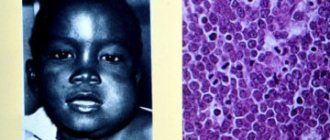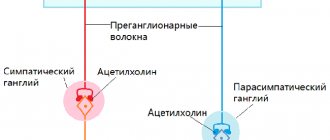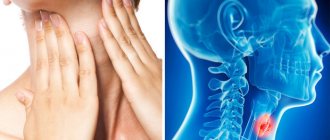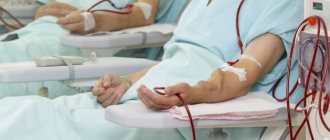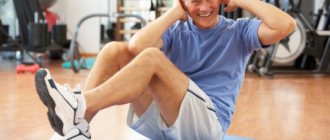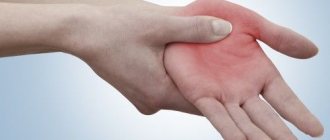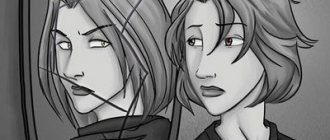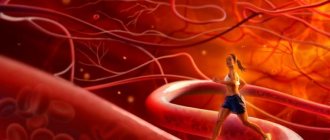A little information
This phenomenon occurs to a person when blood flow is disrupted in vital organs and systems. This happens due to problems in the functioning of the heart. And the reasons for failures can be varied.
First medical aid in case of clinical death should be provided immediately, because in such a state, seconds count. If resuscitation is not timely, irreversible processes will occur in the damaged organs, and it will become impossible to return the patient.
First aid methods and signs of clinical death should be well known to every person, because even absolutely healthy people are not immune from such a situation.
Clinical death in culture
There is a point of view that during an episode of clinical death a person sees an “afterlife.” Some patients who have experienced clinical death describe experiences that are similar to each other (see Near-Death Experiences). Common to all these observations is often a feeling of flight, movement through a dark tunnel towards the light, a feeling of calm and tranquility, meetings with deceased relatives, etc. This phenomenon is called near-death experiences.
The main problem is that the brain almost completely stops working soon after cardiac arrest[1]. It follows that in a state of clinical death, a person, in principle, cannot feel or experience anything.
There are two ways to explain this problem. According to the first, human consciousness can exist independently of the human brain. And near-death experiences could well serve as confirmation of the existence of an afterlife. Most scientists consider such experiences to be hallucinations caused by cerebral hypoxia. According to this point of view, near-death experiences are experienced by people not in a state of clinical death, but at earlier stages of vision of the brain during the pre-agonal state or agony, as well as during the coma, after the patient has been resuscitated.
From the point of view of pathological physiology, these sensations are quite naturally caused. As a result of hypoxia, brain function is inhibited from top to bottom from the neocortex to the archeocortex.
The cerebral cortex is depressed: tunnel vision develops, recognition of images coming from the retina ceases to function - this is what causes the vision of a light spot ahead.
Then the brain stops receiving data from the visual analyzer, and foci of stable excitation of the cortex are formed, supporting the picture of continuous illumination, the person seems to be approaching the light, this illusion arises due to the reverberation of the signal in the visual cortex of the brain, which imitates the intensification and spread of light before the eyes sick.
The sensation of flying or falling occurs as a result of ischemia. There is a lack of oxygen for the vestibular analyzer, as a result of which the brain stops analyzing and adequately perceiving data coming from the receptors of the vestibular apparatus.
Also, in some cases, this condition may be accompanied by specific hallucinations. For religious people, these can indeed be pictures of the afterlife, and what a person sees can vary significantly depending on his life experience and individual characteristics. These hallucinations are often very similar to similar experiences in mental illness[2][3].
Signs of the phenomenon
In such a pathological state, all processes necessary for full life activity stop. So, the signs of clinical death consist precisely in the absence of noticeable phenomena: for example, pulse, breathing.
- The man loses consciousness. Due to disruptions in the blood circulation in the brain, this symptom occurs literally immediately: in the first few seconds.
- The person does not feel a pulse. This symptom is also explained by cessation of blood circulation. You can make sure that there is no pulse by feeling it in the neck area under the jaw. This is where the carotid artery passes, which transports blood to the brain. That is why it is very important to feel the pulse in this place. In children, it is quite difficult to feel the heartbeat in the neck, so you can check it on the wrist.
- The person has no breath. You can verify the presence of this sign by paying attention to the characteristic sounds of inhalations and chest movements. Trying to determine breathing using a simple mirror is a bad solution because it takes too much time. And first aid in case of clinical death must be provided as quickly as possible.
- Human pupils do not respond to lighting. Despite the fact that this sign is clearly present during clinical death, it is not paramount. And all because it can only be noticed after a minute or a minute and a half, so it’s definitely not worth waiting for.
Additionally, before this condition occurs, a person may complain of chest pain, severe shortness of breath, and dizziness. Loss of consciousness can occur in parallel with convulsions, after which the pupils dilate.
How to recognize the onset of clinical death
The terminal state between life and death is a rare and dangerous phenomenon that affects both apparently healthy people and those who suffer from chronic cardiovascular diseases. Physical and emotional stress, poisoning, drowning, electric shock, burns, allergic attacks become risk factors that can negatively affect the functioning of the organs responsible for the vital functions of the body.
Timely recorded signs of clinical death and first aid will help preserve the chance of life if you pay attention to the following typical symptoms in time:
- sharp chest pain, dizziness, convulsions 10-15 seconds before loss of consciousness;
- rapid impairment of respiratory function, characterized by cessation of chest movements and the absence of inhalation and exhalation sounds already in the second minute of the pathological condition, is diagnosed visually;
- unnaturally large dilation of pupils that do not respond to light;
- cardiac arrest - the pulse stops being heard within 5-10 seconds after placing fingers on the carotid arteries located on both sides of the neck between the Adam’s apple and the muscles;
- pale or blue discoloration of the skin and mucous membranes.
Providing first aid in case of clinical death should occur in parallel with the detection and ascertainment of these factors, because time counts by minutes. The faster help is provided to the patient, the greater the likelihood of bringing him back to life.
Important! The duration of the dying stage in people with severe pathologies is reduced to 1-2 minutes. Inhibition of the respiratory and circulatory systems leads to insufficient oxygen supply to the brain, which triggers irreversible reactions to destroy the structure of the brain.
Causes
As already mentioned, clinical death occurs due to cardiac dysfunction.
The reasons for malfunctions in the functioning of such an important organ can be varied:
- excessive emotional or physical stress that can lead to similar consequences;
- severe blood loss;
- allergic, toxic or emotional shock;
- complications of sluggish chronic pathologies of the heart and respiratory organs;
- severe damage to vital organs and the brain.
However, despite the exact reasons that led to this condition, clinical death requires an immediate response in the form of competent first aid.
Clinical death. Resuscitation. methodological development on life safety (grade 11) on the topic
Slide 1
Clinical death. Resuscitation. 11th grade 7th lesson
Slide 2
Lesson questions: Signs of life, signs of death. The concept of resuscitation. Mechanical ventilation (preparatory stage, main part) NMS (preparatory part, main part) Stable lateral position of the victim. Practical work: Development of methods for performing mechanical ventilation, NMS and giving the victim a stable lateral position. Homework: Create a manual on this topic
Slide 3
Actions of a person who witnesses an accident: Assess the situation and the condition of the patient. Ensure safety for yourself and others. Provide primary care depending on severity. Transport to hospital by calling “03”. Monitoring the condition of the victim before transferring him to the ambulance team.
Slide 4
How to determine whether a person is alive or not? Call out Check the pain reaction (behind the ear) Feel (check for injuries) Check the pulse - on the carotid artery The presence of breathing - is determined by the rhythmic movements of the chest.. A living person has a pronounced reaction of the pupils to light. If you shine a flashlight on your eyes, your pupils will shrink.
Slide 5
Artificial ventilation The artificial introduction of air into the lungs. It is performed in all cases of respiratory arrest, as well as in the presence of improper breathing. The main condition is free passage of the respiratory tract and the presence of fresh air.
Slide 6
Technique: Lay horizontally on your back. Free the neck, chest and abdomen from restrictive clothing; Free the oral cavity from saliva and mucus.
Slide 7
Putting one hand on the parietal region, and placing the second under the neck, they tilt his head back to restore patency of the airways. “Mouth-to-nose method” - the person providing assistance closes the patient’s mouth by lifting his lower jaw and, after a deep inhalation, exhales forcefully, wrapping his lips around the patient’s nose.
Slide 8
“Mouth-to-mouth method” - the patient’s nose is closed, and exhalation is carried out into the victim’s mouth, having previously covered it with gauze or a scarf. Then the patient’s mouth and nose are opened slightly, after which passive exhalation occurs. The person providing assistance turns his head to the side and takes normal 1-2 breaths.
Slide 9
Criteria for correct breathing: Movement of the patient’s chest at the time of artificial inhalation and passive exhalation. Do artificial respiration at a frequency of 12-18 artificial breaths per minute!
Slide 10
Indirect cardiac massage: This is a rhythmic compression of the heart, carried out to restore its activity and maintain blood circulation in the body. With indirect cardiac massage, the heart is compressed between the sternum and the spine, as a result of which blood flows from the RV to the pulmonary artery, and from the LV to the systemic circulation.
Slide 11
Technique for performing indirect cardiac massage: Lay the patient with his back on a hard surface. Remove outer clothing, unfasten the waist belt. The palm of the hand is placed on the lower third of the sternum, and the second hand is placed on top of it. Both arms should be straightened at the elbow joints and positioned perpendicular to the surface of the sternum, and both palms should be in a state of maximum extension at the wrist joints, i.e. the fingers should be raised. Frequency 1 time per second. If one person provides assistance, then for 2 deep exhalations there are 10-15 pressures on the chest.
Slide 13
Combination of chest compressions and mechanical ventilation If two people provide assistance, then the distribution of mechanical ventilation to the NMS is 1: 4-5
Slide 14
Stable lateral position Technique: Call out Check reaction to pain Feel Open the airways (raise the head) Move the victim’s right hand to the side, left hand behind your left hand in the lock and under the victim’s head
Slide 15
Bend the left leg at the knee, turn the victim towards you. Straighten your left leg at an angle of 90 degrees - for stability, release your hand from the lock and tilt your head slightly down and back.
Slide 16
Task: Who will you approach first? Why? A man is standing and holding a bloody hand. A man is lying prone. A man is sitting with an unnaturally twisted leg, screaming. A man is lying on his back, the smell of alcohol emanates from him. He is lying on his back, wheezing.
Slide 17
Glossary! Resuscitation is the revival of a dying person, bringing him out of a state of clinical death. Clinical death is a borderline state of direct transition from dying life to biological death. Mechanical ventilation - consists of artificially introducing air into the lungs. Indirect cardiac massage is a rhythmic compression of the heart, carried out in order to restore its activity and maintain blood circulation in the body.
Slide 18
Additional literature: Bogoyavlensky I.F. Providing first medical and first resuscitation aid at the scene of an incident and in emergency situations. St. Petersburg 2005 Vishnevskaya E.L., Barsukova N.K. Fundamentals of life safety. Moscow Russian Word 2000 Mankov V.D. S.F. Zagranichny The danger of electric shock to a person and the procedure for providing first aid in case of accidents at work. St. Petersburg 2006 Markov V.V., Latchuk V.N. Fundamentals of life safety, 11th grade. Mikhailovich V.A. Guide for emergency doctors St. Petersburg “Medicine” 2003 Jonas Jan Atlas of first medical aid Osveta Martin 1988 Youngson R.M First aid Moscow Astrel2002 ru.wikipedia.org/wiki/ www . eurolab. ua/encyclopedia/urgent. medica. aid /328/2287/ cultinfo.ru/fulltext/1/001/008/095/854.htm http://intensive. ru/php/content. php? group =5& id =622
Stages
Since this pathological condition is borderline, there are two options for the outcome of events: either the person returns to consciousness, or final death occurs. The duration of clinical death without first aid is as long as the brain can maintain vitality without the necessary nutrition. Experts distinguish two stages of this phenomenon:
- The first stage takes only 5 minutes. During this time, the body is still able to maintain vital functions. However, if the person is not helped, the risk of death is extremely high. If the body was resuscitated, but after more than 5 minutes, the patient may well survive, remaining disabled. Indeed, during prolonged clinical death, irreversible processes develop in the brain, as a result of which some of its areas simply die off.
- The second stage is longer, but does not occur in all cases. Sometimes all processes in the body slow down, as does tissue death. This happens, for example, with hypothermia. As a result, clinical death can last even several tens of minutes. But such a phenomenon is more rare than the rule.
Resuscitation or revitalization is the restoration of vital functions of the body, primarily breathing and blood circulation. Resuscitation is carried out when there is no breathing and cardiac activity or they are so depressed that they do not provide the minimum needs of the body. This state, i.e. lack of respiratory and cardiac activity can occur with: - electric shock, lightning; - myocardial infarction; - severe mechanical injury to vital organs; - acute poisoning; — drowning or suffocation of various origins; - general freezing; - various types of shock, coma, collapse. The possibility of revival is based on the fact that death never occurs immediately; it is always preceded by a transitional stage - a terminal state. The changes that occur in the body during dying are not immediately irreversible and can be completely eliminated with timely assistance. In the terminal state, a distinction is made between agony and clinical death. Agony is characterized by darkened consciousness, a sharp disturbance in cardiac activity and a drop in blood pressure, respiratory distress, and absence of a pulse. The victim's skin is cold, pale or bluish. After the agony, clinical death occurs. Every person, even those who have nothing to do with medicine, should know and be able to apply simple methods of revival (resuscitation) in case of sudden death in the first 2-3-4 minutes, i.e. prevent the transition of clinical death to biological death. Clinical death is characterized by cessation of blood circulation and breathing, but the possibility of restoring vital functions remains. The most highly organized cells of the human body, the cells of the cerebral cortex, can live without oxygen for no more than 5-6 minutes. After this period they die irrevocably. Clinical death turns into biological or irreversible death. You should know that the duration of clinical death of 5-6 minutes occurs with the sudden development of dying, when tissue reserves of oxygen and energy are preserved and the phenomena of oxygen starvation of cells have not yet developed. If death occurs as a result of a long and serious illness, as its natural ending, then under these conditions clinical death quickly turns into biological death, and even quickly and correctly performed resuscitation does not give a positive result. The effectiveness of resuscitation techniques depends, first of all, on the time factor: in case of a sudden stop of blood circulation, resuscitation started in the first 3 minutes gives positive results 15-18 times more often than in cases where it was carried out in the 4-5th minute. Success in the fight against clinical death is directly dependent on the speed of action of the person who first saw the dying person. Unfortunately, it often happens that a person, even with resuscitation skills, loses precious seconds, because... does not have a clear understanding of the diagnosis of circulatory arrest. Signs of circulatory arrest are divided into early, appearing in the first 10-15 seconds, and late, which are observed in the first 20-60 seconds of clinical death. Early signs include: 1. disappearance of the pulse in large arteries; 2. lack of consciousness; 3. convulsions. The disappearance of the pulse in the carotid artery is the earliest symptom of cessation of blood circulation. The time spent searching for a pulse should be minimal. The second and third fingers are located on the area of the larynx, and then, without applying strong pressure with them, the lateral surface of the neck is felt in the area of the transverse process of the IV cervical vertebra, approximately in the middle of the side of the neck. It should be borne in mind that the absence of a pulse in the radial artery is not a reliable sign of circulatory arrest. For example, during bleeding, with a sharp spasm of blood vessels, the pulse on the radial artery cannot be felt, but the patient may be in a clear consciousness. Loss of consciousness appears 10-12 seconds after the cessation of blood flow through the arterial brain stems. You should be aware that orientation only by this attribute can lead to an error. For example, fainting or a stroke can be mistaken for circulatory arrest. Therefore, the absence of consciousness should be considered an early and reliable, but not the only sign of a lack of blood supply to the brain. To establish circulatory arrest, the presence of three signs is considered sufficient (as stated above) - disappearance of the pulse in the large arteries (carotid), lack of consciousness, and convulsions. Cramps are not a constant sign, but sometimes they are the first thing that catches your eye. Practice shows that many people were saved from death only because doctors or simply literate people, but not doctors, correctly assessed the seizures that appeared and did not attribute them to epilepsy, but instantly checked for other signs of circulatory arrest. Late signs of circulatory arrest include: 1. dilated pupils; 2. respiratory arrest; 3. changes in skin color. Dilation of the pupils without their reaction to light is a sign of oxygen starvation of the cerebral cortex. This is a pretty reliable sign. Simultaneously with the dilation of the pupils, the appearance of a “dry herring shine” is observed. The eye looks dead due to the cessation of tear production and immediate drying of the cornea. It should be remembered that the width of the pupil may depend on the influence of certain medications. Thus, atropine dilates the pupil, and narcotic analgesics and organophosphorus compounds constrict it. Stopping breathing or agonal breathing is one of the absolute guidelines. It is not difficult to establish the absence of spontaneous breathing. Agonal breathing deserves special attention - this is convulsive breathing with a large amplitude of respiratory movements, a short maximum inhalation and a quick and complete exhalation, with a frequency of 2-6 breaths per minute (this is how fish washed ashore breathe). Agonal breathing is an undeniable sign of circulatory arrest. Practice shows that if in this case you start chest compressions, you can do without artificial respiration, because Spontaneous breathing usually returns quickly. The appearance of an earthy-gray color of the skin is the least clear symptom of circulatory arrest. Skin color can be affected by the hemoglobin content in the blood, as well as the action of certain chemicals. Thus, in case of carbon monoxide and cyanide poisoning, the skin color remains pink. Summarizing what has been said, we conclude that the most reliable signs of circulatory arrest are: 1. disappearance of the pulse in large vessels; 2. loss of consciousness; 3. respiratory arrest; 4. pupil dilation. If these signs are present, the diagnosis of “Clinical death” is beyond doubt and it is necessary to carry out measures of the highest urgency - artificial ventilation of the lungs and chest compressions.
Providing first aid in case of clinical death
It is advisable to carry out all resuscitation procedures together, but if necessary, one person can handle it. Providing first aid in case of clinical death is primarily aimed at stabilizing blood circulation and normalizing proper breathing. Before proceeding with resuscitation procedures, it is imperative to call specialists. So, how to provide first aid in case of clinical death?
- In order to resume contractions of the heart ventricles, it is necessary to produce a so-called precordial blow - a sudden and rather strong push with a fist into the chest area. If there is no result from it, you should move on to other manipulations.
- Now it is necessary to carry out pulmonary-cardiac resuscitation. To do this, you need to perform an indirect cardiac massage, alternating it with mouth-to-mouth artificial respiration. At the same time, it is very important to control that oxygen enters the lungs and not the stomach. And to do this, you need to take inhalations not very often, while pinching your nose tightly. It is good if the patient’s chest rises during artificial ventilation. Indirect cardiac massage consists of strong pushes with both hands in the same area. You need to alternate pressing and inhaling according to the standard pattern: 30 through 2. The manipulations must be repeated systematically. After five cycles, the patient's breathing and heartbeat should be checked.
Emergency first aid methods for victims
Signs of clinical death and first medical aid require efficiency and the ability to competently organize the auxiliary process. The borderline situation of a patient who finds himself on the verge of death does not tolerate conversations, discussions and experiments with determining signs of breathing and the presence of a pulse. Every second can be decisive, and delay and wrong actions can lead to disastrous consequences without a chance of salvation.
First aid for clinical death involves performing a precordial blow to the chest, which causes the heart muscles to contract rhythmically and restores the activity of the main circulatory organ. The main conditions for the effectiveness of such manipulation are cardiac arrest for no more than 30 seconds, absence of clothing at the site of the blow, and mastery of the execution technique. If the mechanical technique did not contribute to the start of cardiac activity and the pulse still continues not to be palpable, you should urgently move on to a set of rehabilitation measures.
The first aid algorithm in case of clinical death includes steps that are performed in a specific order.
- Place the patient on a flat and hard surface.
- Place a cushion under your neck and tilt your head back so that your chin rises up;
- By pressing your fingers on the cheekbones, open your mouth and, using a handkerchief or napkin, remove any mechanical objects and substances that impede normal air circulation: food, sand, vomit, mucus, blood.
- Perform artificial respiration “mouth to mouth” or “mouth to nose”. In order for the air to enter the lungs in full, it is important to prevent it from leaking due to a loose nose or a loose mouth. The optimal intensity of insufflations should be about 13-16 times per minute; exhalation from the victim’s mouth and movement of the chest indicate positive changes in the functioning of the organs.
- Attach a closed cardiac massage, alternating smooth and rhythmic pressing of the hands into the chest area with blowing according to the scheme: 30 pushes - 2 exhalations into the mouth. After every 5 cycles, check the appearance of pulse and breathing, spending no more than 5 seconds checking.
Important! Resuscitation efforts are only effective in the first three minutes after cardiac arrest. The revival process, begun at a later date, has a high probability of ending in death.
When resuscitation is not needed
In certain cases, it is not necessary to provide first aid in case of clinical death in the following ways:
- if the patient is conscious;
- if there are signs of life: be it breathing or pulse;
- in case of symptoms of biological death - rigor or the appearance of cadaveric spots;
- if before this pathological condition the person already suffered from an incurable disease and practically died.
Medical methods of assistance
Providing first aid in case of clinical death involves mandatory informing doctors about what happened, indicating the location of the patient and the accompanying loss of consciousness symptoms. Measures carried out by non-specialists slow down irreversible changes, but do not eliminate the need for medical intervention. The participation of doctors is carried out after the efforts of non-professional rescuers managed to restore independent breathing, consciousness and pulsation in the large arteries. The responsibilities of doctors also include artificial ventilation of the lungs and cardiac massage, but with the use of special therapeutic equipment and medications.
Possible Consequence
In some situations, with correctly provided first aid in case of clinical death, the vital functions of the human body are stabilized, however, he does not regain consciousness. In this case, the patient goes from a pathological state to a coma, in which he can remain for quite a long time.
It is noteworthy that at the same time a person’s heart functions, as well as the respiratory system. The depth of this condition and further prognosis can only be determined by how severely the patient’s brain was injured.
Clinical death: causes of the disease, main symptoms, treatment and prevention
An emergency pathological condition, which is the initial stage of the death of the body, occurring at the moment of cardiac arrest and cessation of the respiratory system.
Causes
Causes that can cause clinical death include diseases and traumatic injuries that can cause the death of a person.
This list does not include injuries incompatible with life that a person received during an accident.
Experts divide all the reasons that can lead to the occurrence of this emergency condition into two large groups - unrelated and related to myocardial damage.
Cardiac is a primary disorder of the contractile function of the heart that occurs against the background of acute coronary pathology or the influence of substances that have a cardiotoxic effect.
Such factors can cause mechanical damage to the myocardium, tamponade, as well as disruption of the conduction system, as well as the functioning of the sinoatrial node.
Stopping blood flow can be caused by acute myocardial infarction, water-electrolyte imbalance, arrhythmia, disruption of the integrity of the walls of the aortic aneurysm, endocarditis and coronary heart disease.
Non-cardiac are conditions characterized by the development of severe hypoxia, for example, drowning, suffocation, airway obstruction and acute respiratory failure, shock, embolism, poisoning with cardiotoxic poisons or endotoxins. Fibrillation with further cardiac arrest, which occurred against the background of incorrect administration of cardiac glycosides, potassium supplements, antiarrhythmic drugs and barbiturates.
Symptoms
Clinical death is caused by the development of certain signs: lack of heartbeat, consciousness and breathing. The main manifestation of this pathology is the presence of all these signs that appear in the patient simultaneously. If consciousness or heartbeat is preserved, this diagnosis is not made.
In case of clinical death, spontaneous breathing can last for thirty seconds after the blood flow stops.
During the first minutes, there may be individual ineffective heart contractions, which are accompanied by the presence of mild pulsating impulses, the frequency of which can vary from 2 to 5 times per minute.
Secondary signs of clinical death are the absence of muscle tone, motor activity, reflexes and the unnatural position of the patient’s body.
The victim's skin is pale, sometimes with an earthy tint, there is no blood pressure, after 90 seconds the pupils dilate to a diameter of more than 5 mm, and they do not react to light. The patient has sharpened facial features.
Due to the fact that clinical death turns into biological death 10 or 12 minutes after cardiac arrest, when the duration of clinical death is more than 5 or 7 minutes, a violation of some brain functions or its complete death may occur.
Diagnostics
Clinical death is quite easy to diagnose by external signs. In the event that an emergency condition occurs in a medical institution, additional hardware and laboratory methods are used, which will allow the selection of the most effective resuscitation measures.
Diagnosis is carried out in conjunction with measures aimed at restoring heart rhythm. For this, the patient may be prescribed a physical examination, pulse counting, auscultation of coronary sounds and respiratory sounds, determination of blood pressure, and an electrocardiogram.
Treatment
All treatment measures are aimed at restoring vital functions and are carried out using basic and specialized resuscitation measures. Such activities should begin as soon as possible, in the best case no later than 15 seconds, after the blood flow stops.
To provide emergency care, the patient is placed on a hard, flat surface, then his head is tilted back, and a cushion is placed under his shoulders. Then the lower jaw is moved forward, the airways are cleared, and an indirect cardiac massage is performed, which is combined with artificial respiration.
Among the medications during resuscitation measures, the patient is given intravenous administration of adrenaline, mesatone, atropine, and calcium chloride.
To maintain blood pressure after restoration of the heart rhythm, pressor amines are administered through a syringe pump. Metabolic acidosis is eliminated by administering sodium bicarbonate through infusion.
An increase in circulating blood volume occurs through the administration of colloidal solutions.
Prevention
Prevention of clinical death is based on timely hospitalization of the patient and the organization of constant monitoring of the patient with a high risk of developing this condition.
Source: https://www.obozrevatel.com/health/bolezni/klinicheskaya-smert.htm

